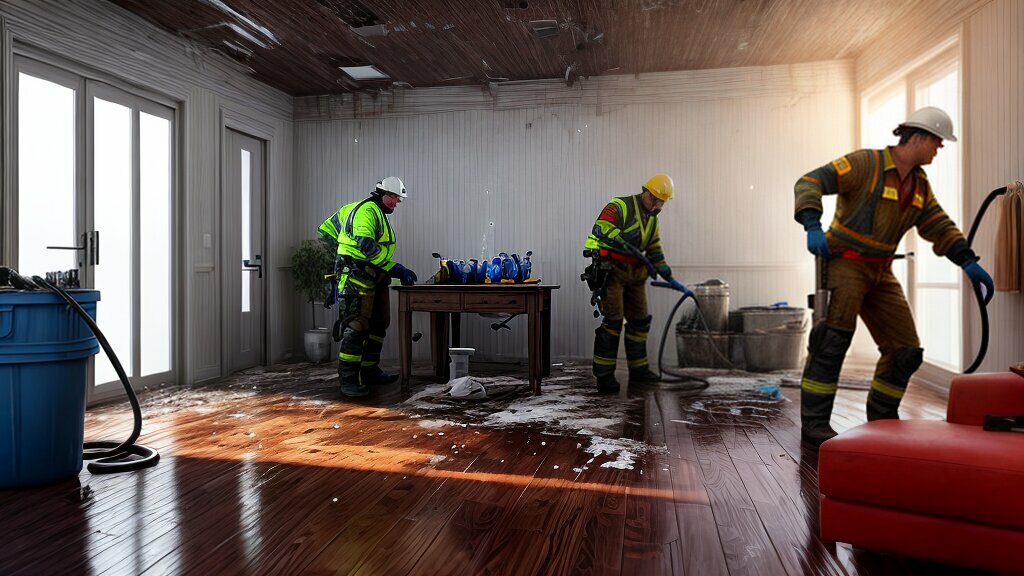Ever seen a small water leak and thought it was no big deal? Think again. A small leak can cause big problems for your home’s structure. It’s not just about floods or hurricanes causing damage. Even a tiny leak can hurt your home’s foundation and lead to big repair costs.
This article will show you how water leaks can damage important parts of your home. It could mean you’ll need to fix a lot of property and pay for water damage fixes.
Key Takeaways
- Water leaks can severely compromise a building’s structural integrity over time.
- Signs of structural damage include leaning windows, door frames, and difficulty opening doors and windows.
- Corroding metal foundations and rusting structural components are common results of water leaks.
- Licensed IICRC-certified restoration experts are recommended for accurate assessment and repair.
- Addressing water leaks early can prevent long-term and costly property damage.
Understanding Structural Damage
Structural damage means harm to a building’s key support systems. These include walls that bear weight, the foundation, and other vital parts. They make sure the building stays stable and strong.
Damage to the foundation can seriously harm the whole building. It might lead to parts falling apart. This often happens because of water getting in or because of bad weather like storms and floods. If you ignore these problems, the damage could get worse, even causing the building to collapse.
Following building codes is crucial when fixing these issues. It keeps the building safe and lasting longer. Keeping the building’s core strong, including its walls and foundation, helps avoid future problems.
How Water Leaks Affect Structural Integrity
Water leaks are a big threat to a home’s structure. When water gets into the soil near a foundation, it weakens the foundation. This makes the whole building at risk. Water damage doesn’t just stop there; it also harms wooden parts of the building, leading to rot and weakening the support.
Signs of Structural Damage from Water Leaks
Spotting early signs of structural damage from water leaks is key to keeping your home safe and avoiding big repair bills. Many signs can point to hidden problems. A detailed home inspection is often needed to find these issues.
Water spots on ceilings and walls are a clear sign of damage. These spots are usually discolored and can get bigger over time, showing there’s a leak. A roof that leans or sags could mean it’s not strong anymore because of too much water, which can harm its structure.
Outside, cracks in the yard can mean the foundation is shifting because of water getting in. This can make the structure unstable. Doors and windows that don’t open or close right might also mean the foundation has moved, showing the importance of a thorough inspection.
Homeowners must act fast when they see these signs. Ignoring them can lead to big problems with the foundation. Taking steps like regular inspections helps catch and fix water damage early. This way, you avoid huge repair costs and risks like your home collapsing.
Is a Water Leak Considered Structural Damage?
Water leaks can be seen as structural damage, depending on how severe and where they happen. Knowing this is key because it tells us what repairs are needed and how to check for problems. For instance, if walls that hold up the house break or the roof’s key parts get damaged, it’s considered structural damage. This can really affect how safe and comfortable the house is.
On the other hand, issues like broken windows or tiny cracks in the foundation don’t threaten the house’s stability. Yet, water leaks can still cause big problems if they’re not fixed quickly.
Insurance policies for water damage from leaks can change based on the cause and the policy details. Homeowners should look at their policies closely. This way, they’ll know what kinds of water damage are covered. This helps them be ready for any structural damage issues.
Non-Structural Vs. Structural Water Damage
It’s key to know the difference between non-structural and structural water damage. Non-structural damage doesn’t affect a building’s stability or safety. Examples include roof tile damage, ceiling stains, and wall issues. These problems mainly affect how well a home is lived in, not its safety.
On the other hand, structural water damage hits the building’s core parts like roof joists, wall frames, and the foundation. This kind of damage is a big threat to the property’s safety. If not fixed, it could lead to a building collapse, putting people at risk.
Knowing the difference between non-structural and structural water damage helps in fixing the right problems. It also matters when making insurance claims, as insurers treat these damages differently. Homeowners should watch for both types of damage early to keep their property safe and sound.
Addressing and Repairing Water-Induced Structural Damage
Fixing water damage is key to keeping buildings safe for a long time. Starting repairs early stops more damage and lowers risks. Experts in water damage and structural engineering are crucial to find hidden problems.
They can tackle mold and do the needed fixes or rebuilds. Their skills help manage damage safely and meet safety rules. Fixing water damage means:
- Doing a deep check to see what needs fixing.
- Using services to get rid of extra water and moisture.
- Fixing the structure to make it strong again.
- Watching closely to stop more problems and keep things solid.
Working with skilled contractors or water damage experts like C&B Complete makes sure repairs are done right and safely.
Conclusion
Water leaks might seem small but can cause big problems for buildings. They can weaken the structure and lower property value. It’s important for owners to spot water damage early to keep their buildings strong.
Knowing the difference between structural and non-structural water damage helps owners make smart choices. Some leaks look harmless but can cause big issues if ignored. This shows why it’s key to get experts for checks and fixes.
Keeping an eye on water leaks is crucial for protecting homes and properties. Taking steps to fix leaks early helps keep buildings strong and valuable over time. These actions are key to avoiding damage and keeping properties in good shape.









